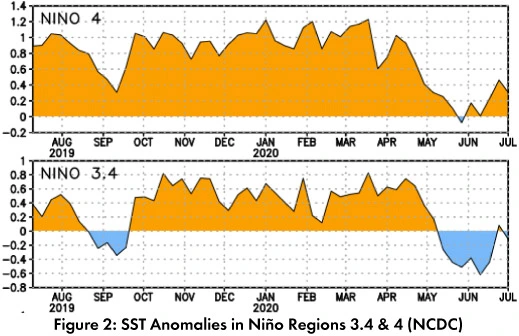Southwest Climate Outlook - El Niño Tracker - July 2020
Sea surface temperatures (SSTs) are cooling across the equatorial Pacific but are still mostly in the range of normal (Figs. 1-2). Conditions are forecast to remain ENSO-neutral through summer 2020, while seasonal outlooks point to a possible La Nina event by fall or winter 2020.


Forecast Roundup: On July 7, the Australian Bureau of Meteorology issued a La Nina watch, noting cooling SSTs, even while atmospheric indicators were still in the range of neutral. On July 9, the NOAA Climate Prediction Center (CPC) issued its ENSO diagnostic discussion with a La Nina Watch status. The CPC called for a 50- to 55-percent chance of ENSOneutral during fall 2020, and a 50-percent chance of La Nina lasting till winter 2020-2021. On July 9, the International Research Institute (IRI) issued an ENSO Quick Look (Fig. 3), noting “the average of the forecasts of many models for fall and winter slightly exceed the borderline of weak La Niña SST conditions.” On July 10, the Japanese Meteorological Agency (JMA) maintained its call for a 60-percent chance of ENSO-neutral conditions to last through summer 2020. The North American Multi-Model Ensemble (NMME) has swung to netural and the ensemble mean is projected to move closer to La Nina conditions later in 2020 (dashed black line, Fig. 4).


Summary: Oceanic conditions have cooled, and oceanic and atmospheric conditions remained ENSO-neutral over the last month. Most forecasts call for these conditions to remain ENSO-neutral through the summer, but by fall, it is essentially a toss-up between ENSO-neutral and La Nina. The tone of the forecasts further highlights the uncertainty associated with the current forecasts, and the weak-to-borderline intensity of the event were a La Nina to develop. A La Nina event would likely matter for precipitation in the U.S. Southwest, as La Nina can suppress tropical storm activity in the Fall, and often leads to drier than normal conditions in the winter.
Online Resources
- Figures 1 - Australian Bureau of Meteorology - bom.gov.au/climate/enso
- Figure 2 - NOAA - Climate Prediction Center - cpc.ncep.noaa.gov
- Figure 3 - International Research Institute for Climate and Society - iri.columbia.edu
- Figure 4 - NOAA - Climate Prediction Center - cpc.ncep.noaa.gov

